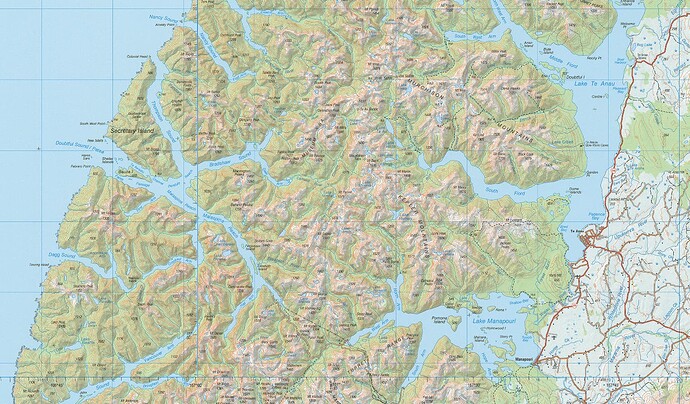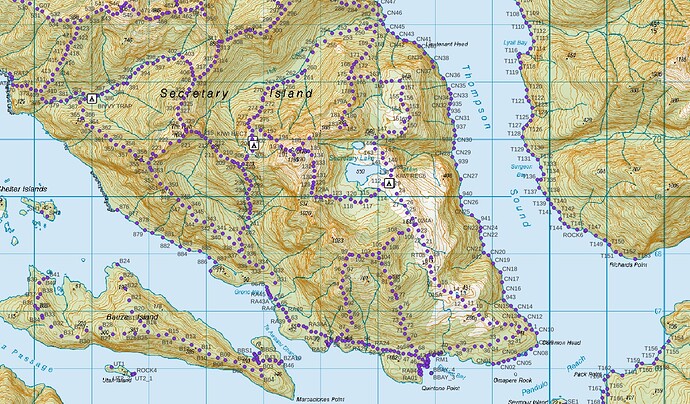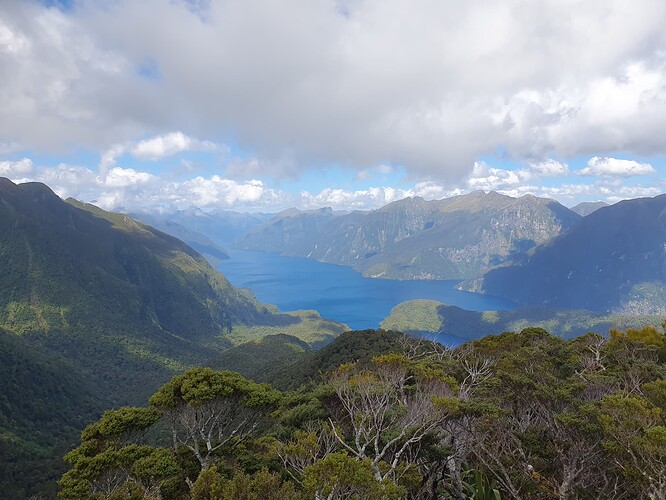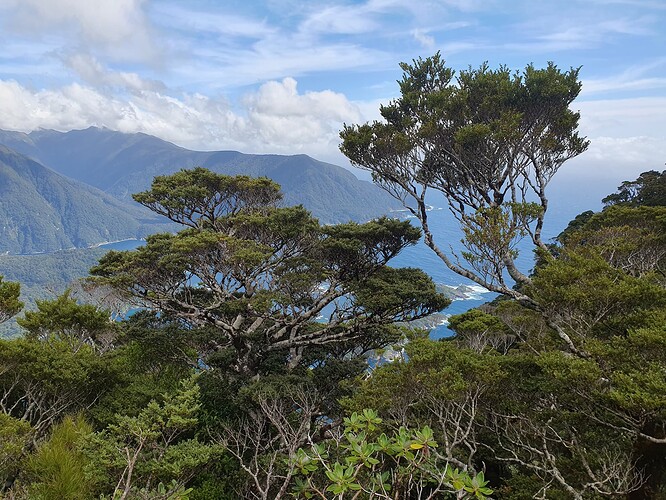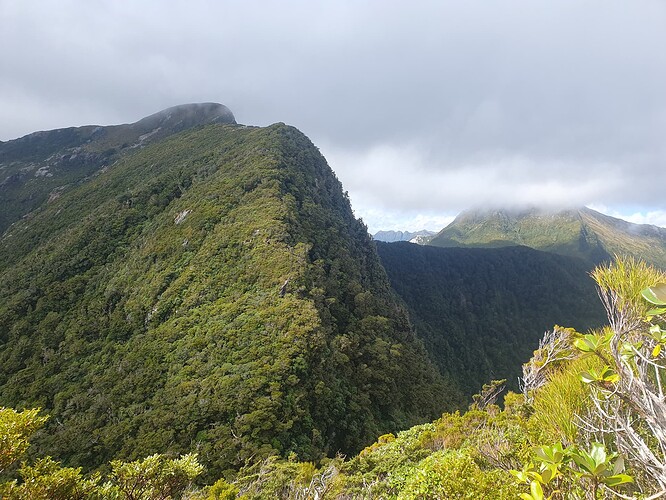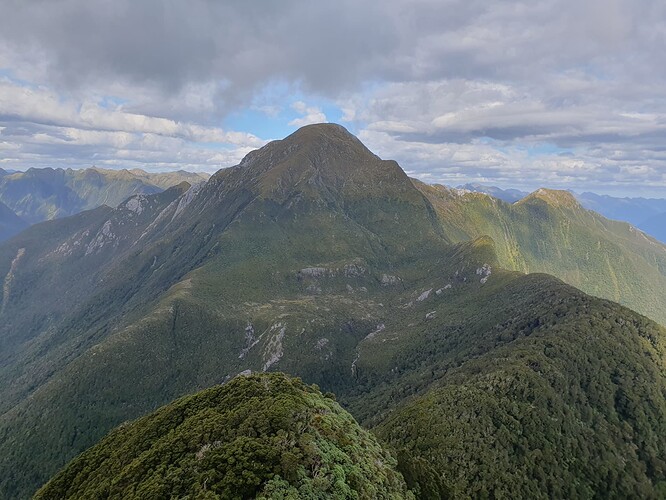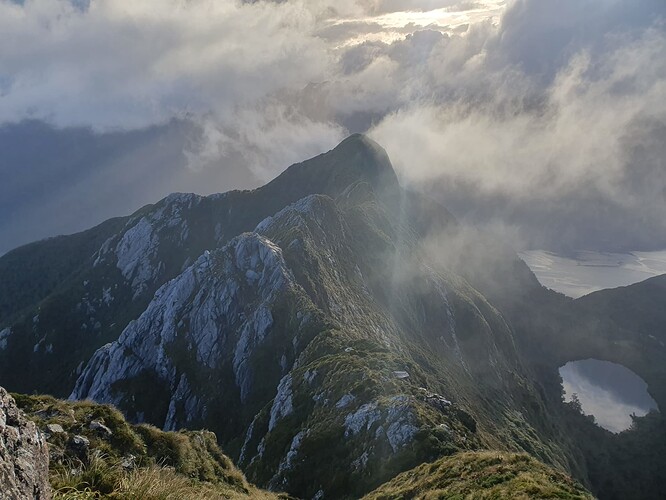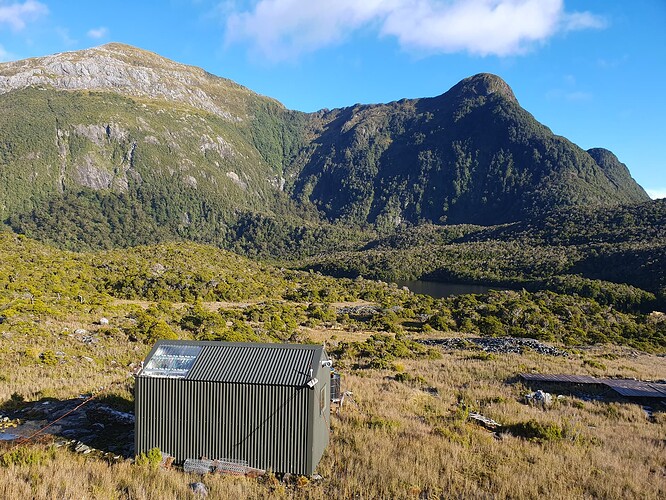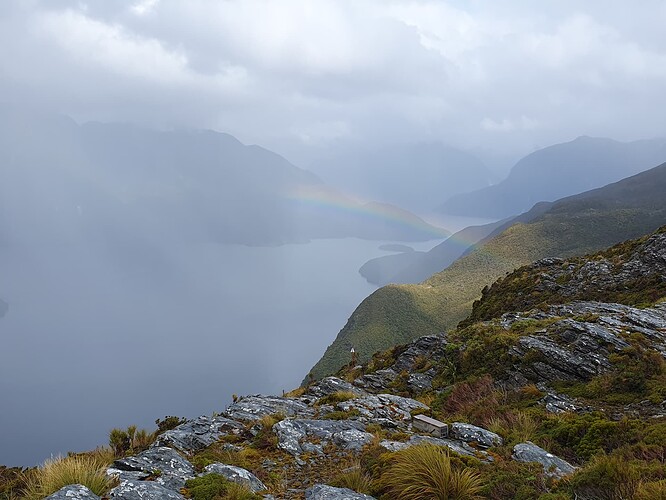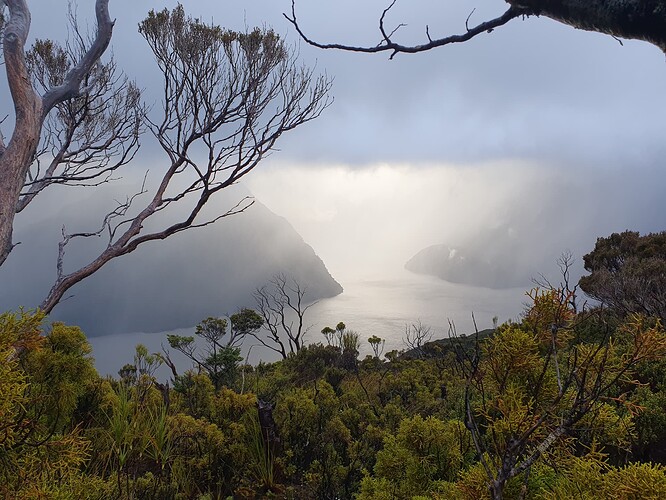Secretary Island
Conservation and radio do mix!
Returning into coverage after a 5-day stint cutting tracks in the Haast Ranges, I was delighted to find an email waiting in my inbox asking if I’d be available to run stoat-trap lines on Secretary Island the following week. ‘Sorry for the short notice, we understand if you have other commitments …’ Well, any commitments I did have get pretty rapidly re-prioritised, re-arranged and dumped for the opportunity to visit this island.
Secretary Island [ZLI/SL-253] sits, wedge-shaped, in the mouth of Doubtful Sound on the West coast of Fiordland, New Zealand. Even in the remoteness of the Fiordland mainland, invasive predators have spread and decimated the native birdlife, invasive deer have altered the make-up of the plant ecosystems. But with the exception of stoats and occasional deer, these species have never made it across the sound to Secretary. As a result it’s near pristine ecosystem is a refuge for many bird, plant and lizard species now threatened or completely extinct on the mainland.
A quarterly programme of stoat trapping along several hundred kilometers of traplines aims to one day eradicate stoats from the island- leaving it truly predator free, and in the meantime suppress them to levels that allow birds to continue to fledge their chicks successfully.
==
Our crew of four trappers meet up in Te Anau on the Monday for biosecurity / quarantine. We must clean all our gear of soil and seeds prior to travel, and the Dept of Conservation run a strict check on all equipment flown to the Island.
The Metservice forecast for the Tuesday is abysmal, a strong front with winds and heavy rain. But the Te Anau Heli pilots seem to have a direct line to the weather gods and assure us that contrary to the published forecast the front will move through by morning.
Sure enough, by 9am we’re sneaking through the passes of the Southern Alps, skimming the base of the cloud and just a few meters above the treetops. Then, flying high above the dark waters of Doubtful Sound, between sheer forested walls - to where Secretary Island lies cloud-shrouded at its mouth.
==
The moment a chopper leaves you at any remote place is always magical. The noise, stress and bustle of the flight is replaced in an instant by the tranquility, the remoteness of Fiordland. I take a few deep breaths, watch the chopper vanish over the pass, am left alone and remote. I hear nothing but distant waterfalls, the wind in trees, the slow return of the birdsong.
Day 1 – The Hub
Taking advantage of the unforecast dry weather I take on the long loop south down to the coast at Te Awaatu channel, then the long steady climb back to the summit of The Hub [ZL3/FL-728], before dropping back west to my biv on the western flank of Mt Grono. As The Hub is a SOTA summit, the radio comes along for the walk.
Ridge from The Hub down to Te Awaatu Channel – Bauza Island in Doubtful Sound below
The tracks on the island are well maintained, but not for the faint hearted. A steep, slippery scramble descends near vertically south to the creek draining Mt Grono, before the more sensible gradients of the spur beyond are reached.
We are baiting traps with alternating bait types – even numbers getting an egg and a chunk of raw rabbit meat, the odd numbers a strip of scented towelling that has been used as bedding for domesticated ferrets, along with a square of jerky. Each trap must be checked, cleaned of debris, old bait and any previous catch. Any stoats caught are to be bagged and flown out at the end of the trip for DNA analysis to determine the population of the island. A catch of any other species, such as rats, which have been absent from the island, will result in an immediate alert to the Dept of Conservation via satellite message, and a full scale incursion response. Track marking is to be maintained, where lacking, and minor windfall dealt to by handtools.
Fiordland Coastline
The knife-edge ridgeline leading to the hub is, thankfully, tree-covered – providing plenty to cling onto on the otherwise exposed scramble.
Ascent to The Hub, Mt Grono beyond
On the summit of The Hub [ZL3/FL-728], I set up the EFHW on the narrow summit ridge, struggling to guy it securely. The steep drop-off on each side means I’d need guy ropes at least a couple of meters longer than my usual flat-land guys to reach the ground. I am forced to make do with a very low guypoint barely a meter up the 6m SOTA-pole.
An electrical storm renders 40m unusable – the entire band is filled with the near-continuous noise of S9+ static crashes. But 20m proves a viable option, occasional crashes at S5 aside. A spot via inreach brings a rapid succession of VK and ZL1 stations, but the activation is soon interrupted as the gusting wind brings down my mast and antenna. Restanding it, and applying more tension to both guy ropes and antenna wire, I return to the FT818 and continue through the bemused VK pileup. But 5 minutes later the same happens again. Another quick repair job nets another two contacts bringing the total to a respective ten, before mid-QSO a strong gust brings the mast crashing down again, snapping the antenna wire both at the summit and at the transformer.
I crawl out of my sheltered hollow and stand to again try to resurrect the antenna, but another gust of wind takes me nearly off my feet, and has me cowering again among the scrub. Whilst it galls me to leave the biggest pile-up I’ve had in almost a year, I decide that it really is time to get myself off this mountain, whilst I still can. Gear is swiftly and chaotically stowed, and I scuttle and crawl east down the exposed spur to the relative safety of the bush-clad ridge below, and continue to check & rebait the traps back to Mt Grono Biv [ZLH/SL-142] below Mt Grono. The days work has netted me 10 SOTA contacts and 4 stoats.
Mt Grono from The Hub. Mt Grino biv on terrace below the peak.
Torrential rain starts, just as I arrive, but whipping on a coat I manage to erect the antenna and mast and feed the coax in through the window. I strip off and exit the hut for a quick dip in the tarn outside though why I bother, I don’t know, as the 30 seconds trip to the tarn in the ongoing downpour would have scoured all dirt and sweat of the day off me.
Back in the biv, the first of the thunder crashes roll in, bouncing round the surrounding peaks and shaking the tiny biv almost as much as the wind gusts which set it straining against it’s guy wires. As light fades and tea cooks on the gas stove, I count milliseconds between flash and bang – the summit of Mt Grono is less than 1km away.
The thunder finally eases – though the wind continues as strong as ever. I tune around on 20m, managing one contact with Saki, JK7TKG before retiring to bed to listen to the wind.
Around midnight I attempt to exit for a pee, but even cautiously cracking the door open an inch it takes all my strength to hold onto it and stop it being ripped from the wall. With effort I pull it closed, and dedicate a ‘chamber’ pot in place of the great outdoors.
Day 2 – Mt Grono
The forecast for day 2 mirrors that of day 1, a clear morning with storms in the early afternoon. I wake well before dawn and climb the steep tussock spur to Mt Grono in the
early half light. Given the weather and the need for speed, the radio stays at the hut.
Ridgeline north from Mt Grono
The ridgeline north of Mt Grono is steep, sheer and exposed - and I am again thankful for the clear, still day. On the most exposed parts I feel I could throw a rock into Lake Secretary 500m below. A gentle breeze billows light cloud over the ridge in a gentle cascade. Clearing at times to display the grandeur of the landcape, before closing in again to obscure all but the next 20 meters.
Beyond the interesting ridgeline, I climb the final pyramid peak and drop through first scrub and later mature tall-standing bush to the northern coastline. Kaka are everywhere, their melodious calls in the trees above me, their guttural ‘carr’ from the skies above. The return jourey leads back south, up the boulder-scattered floor of Nee Stream, then the sheer climb back to the Mt Grono biv terrace: a 600 vertical-meter climb in under 700 horizontal meters that only the ability of the thick Fiordland vegetation to grow on sheer mountainsides makes possible. The day nets no further stoats, but the tramping and scenery speak for themselves.
Again, torrential rain sets in just as I arrive at the biv, and this time I skip the dip in the tarn and merely scrub myself clean in the downpour before scurrying back inside for a warm cup of tea and an evening of radio. A relaxed session nets 17 contacts – mostly locals from ZL and VK, but also stations as far away as Texas (@KG5CIK), Finland (@OH1MM) and Spain (@EA2GIB).
I enjoy these evenings of radio, the relaxed pace making it as much rag-chew as activation. A couple of other ZL stations are out and about touring the South Island chasing summits and lakes during the week, and we manage relaxing chats about our day’s adventures.
Day 3 – To Lake Secretary
Having completed the trap-servicing around Mt Grono Biv, on day three I pack up all my gear into my tramping pack and lug it over Mt Grono and down to Lake Secretary [ZLL/1020] on the far side. Lake Secretary Hut [ZLH/SL-143] will be my base for the rest of the trip. This gives me the perfect excuse for an activation of Mt Grono [ZL3/FL-616]: at 1196m, the highest point on the island - and a 4-pointer at that. The morning dawns claggy, and so this time cloud, rather than wind denies me the ‘activation photo’. But thankfully the rain holds off, and despite operating with the radio in the dry-bag (making signal reports tricky) it is a pleasant half-hour. On 20m the first CQ results in an instant response from Chris (@F4WBN), by far my most frequent European chaser, and presumably at the radio late into the night given the 2100UTC time. 17 contacts in the bag, I leave the still-clagged summit to weave my way down through the limestone bluffs to the Lake Secretary basin below.
Lake Secretary Biv, Mt Grono beyond.
The afternoon sees me wade the deep lake outlet above the falls, and cross the broad barren plateau to complete the trapline loop back to the northern ridge on Mt Grono in an afternoon of light drizzle. 17 SOTA contacts and one additional stoat the tally for the days work.
Thompson Sound, from terraces north of Lake Secretary
Days 4-5 - Eastern traplines
The following 2 days see me check and rebait the network of traplines at the eastern end of the island, dropping to the coast each day and returning via another route to complete a trap-loop. The weather deteriorates for the latter half of the trip, the brief stormy downpours of the early trip replaced by a steady rain that works through clothing and leaves everything damp. The gentler terrain of the eastern island, however, makes for safer travel in the poor conditions.
Bradshaw Sound as showers pass
I visit The Gut Hut [ZLH/SL-120] on the coast, and bag my 656th public NZ backcountry hut (there are some 950 in the country). I watch a cruise ship slide incongruously by at Captains Point – so man-made and alien in this remote environment. I attempt to survey kea, amongst flocks of kaka. I rebait traps, remove & bag carcasses for DNA analysis. I search for and remove weeds at the chopper pads and huts. And I slowly absorb the scent of the ferret-bedding lure used in every second trap.
And each night the radio gets turned on at lake Secretary Hut for another activation of Lake Secretary Hut, Lake Secretary, Secretary Island, Fiordland National Park, and OC-203.
===
Day 6 arrives quickly along with the chopper home. Four tired but exhilarated trappers out from bivs on the 4 quarters of the island. Sharing tales and experiences. Smelling of ferret.
The team has caught some 34 stoats, checked some 1390 traps and walked some 280km through this remote and rugged landscape.
==
A big thankyou to all those chasers, friends and rag-chewers who kept me company on this trip. The radio, the company counterbalancing the conservation, the walking, the stunning environment to make for a memorable, beautiful journey.
